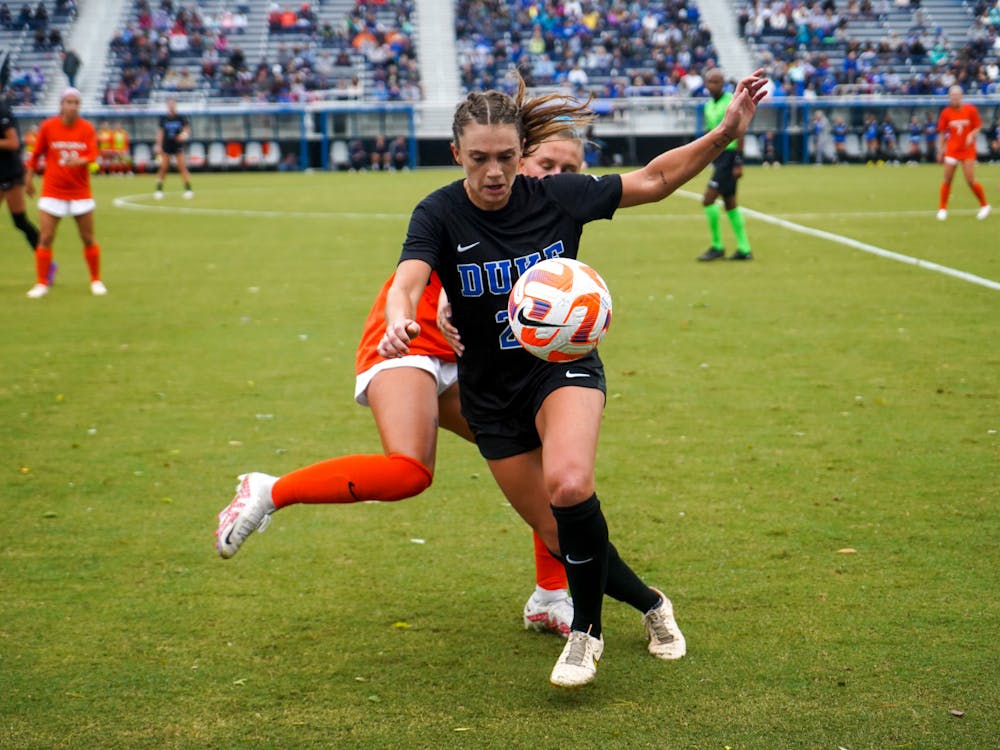A hallmark of Duke's program has been its schematic shapeshifting; over the past five years, the Blue Devils have played in a standard 4-3-3, a 4-3-3 with wingbacks, a 4-4-2 box, a 4-3-3 with wingbacks again, a 5-1-2-2, a 4-2-3-1, a 5-4-1 and a 3-4-2-1.
In its continual quest for strategic innovation, Duke is now trying something groundbreaking: playing two formations at once.
“[Our formation] just depends on what we're doing, if we're in-possession or out-of-possession,” Blue Devil head coach Robbie Church said after a win at N.C. State. “Defending, we're defending out of a 4-2-3-1. And then we kind of play into the 4-3-3 attacking—we go into a different shape attacking.”
Three weeks ago, Duke started tinkering with its formation, spending much of a 1-0 win at Syracuse in a 4-3-3. Its intended effect was clear, as striker Kat Rader and attacking midfielder Maggie Graham helped lead a dominant second half for the Blue Devil offense. That continued into their next game, in which Rader broke out with a goal on four shots (including a career-high three on goal) as part of a 3-0 win against Boston College. And Duke fully unveiled its shapeshifting scheme Sept. 25 in a historic 6-0 beatdown of then-No. 22 N.C. State.
The Blue Devils’ Sunday loss to No. 2 Virginia interrupted the era of good feelings, but that game was about as evenly played as possible. Duke put up a better fight against the Cavaliers than it did against the fifth-ranked Tar Heels, and the passing angles and fluidity allowed by the new 4-2-3-1/4-3-3 hybrid were a significant factor.
Over those four games, the Blue Devils controlled possession for 62% of the match, with more than half that time coming on the opponent’s side of the field against the Eagles and Wolfpack.
“[The formation change] gives us a lot more freedom, just having better passing angles,” forward Mackenzie Pluck said after the win in Raleigh. “‘One-v-ones’ are my favorites, and when I get in those zones, it's been nice, which has been helpful for me. [These] formations have been fluid, which is also good— just changing it up so we don't have [opposing] teams know exactly what we're doing … So as long as we can keep doing it, we'll keep scoring.”
The apparent impetus for Duke's newest challenge to the ACC Network team in charge of pregame graphics was the struggles of the backs. With both of the Blue Devils’ main center-back trios (Emily Royson, Katie Groff and one of Jenna Royson or Baleigh Bruster) having trouble preventing transition opportunities and the offensive midfield replete with talent, Church simply opted to play fewer defenders. The three-backs-plus-wingbacks defensive line has been reverted to a two-backs-plus-wingbacks line, which the team last ran two years ago.
But the change has not just helped the back line. Groff sitting in the pivot instead of center back has allowed her technical skills to shine without needing to match the Roysons’ speed. Graham moving from the forward rotation to a true attacking midfielder plays to her strengths in controlling possession and connecting the lines, while relieving her of finishing responsibilities. Cooper shifting down from center forward to second striker has enabled her to threaten as both a scorer and a passer while allowing Rader to focus on finishing, and defenses have yet to find an adjustment: Cooper currently ranks first in goals per game and third in assists per game among all ACC players.
“I'm now sitting in a little more, so being able to … take the energy that I'm not physically exerting to helping by encouraging [others] is something that I definitely do a little more,” said Cooper.
In truth, to say that Duke is simultaneously playing two different formations is both technically accurate and a bit misleading; eight of the Blue Devils on the pitch are playing in the same spots regardless of whether they are attacking or defending. The change between the attacking and defending shapes is that, once Duke moves from in to out of possession, Cooper slides upfield from the rest of the offensive line, Graham moves up to play at the same level as Pluck and Rader, and box-to-box midfielder Sophie Jones slides down to play at the same level as Groff at holding midfielder.
With Jenna Royson and Bruster competing for center-back minutes, Devin Lynch continuing to earn more playing time, and Carina Lageyre back from injury, the Blue Devils are finding themselves with more quality players than they have opportunities for.
“We're just gonna share some time [in the rotations], we're all just gonna work hard and then get somebody else in and they're gonna work,” said Church. “Our defense is better [now]; when we're taking a player away from the back, we have to be better up front.”
Get The Chronicle straight to your inbox
Signup for our weekly newsletter. Cancel at any time.

